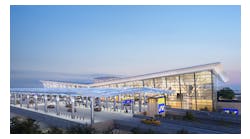Walt Disney World is known as the most magical place on earth. Millions of visitors visit these parks with high expectations of losing themselves in an alternate reality set amongst the various themes and characters. Visitors will also stand in line for rides and other attractions to further enhance that overall experience.
Of course, when I think about it, I can't help but see the similarities between the world-famous theme parks and the airport terminals I’ve worked in throughout my career.
Then again, I’ve never heard anyone call an airport a magical place, but stick with me on this epiphany.
A few years ago, I took a behind-the-scenes tour at Disney with a group of architects and Imagineers who worked there. We walked through Disney Springs and Animal Kingdom, where they discussed design concepts and themes that tie into the overall experiences. They also got into the nitty gritty of restrooms and their placement, fixtures and specific design in the parks, such as placing reinforced curbs along pathways to resist impact from motorized scooters. During this visit, we discussed the long lines for attractions and how Disney adds exhibits for visitors to explore while waiting.
When you go to an amusement park, you go there for an experience. Unfortunately, visitors cannot simply walk directly onto a ride or attraction – they must wait. This experience is parallel to what we have at an airport. When traveling through an airport, we’re all waiting in some sort of line for the main attraction: a ride on an aircraft to our next adventure.
There are many correlations between airports and amusement parks, even if we don’t see or value them as similar experiences. But why can’t we have more of a theme park experience at the airport?
The airport can be an overwhelming place. People are everywhere, a mix of experienced and novice travelers with everyone in between. Airports constantly struggle with the question: how do we streamline the processes in our airports to make them more user-friendly for everyone?
We have often thought the answer is a bigger lobby, perhaps with a big experiential approach such as sculpture, enhanced electronic signage, live walls, music, and other similar solutions. These types of approaches are very attractive and establish an identity for the airport where the experiences reside, but there are underlying experiences that are consistent at every airport.
Passengers must still access the terminal, get past the ticket counter, check bags, and move through security screening and onto their gate. These steps in the process add to the overall experience in airports.
According to the J.D. Power 2023 North America Airport Satisfaction Study, passengers’ overall satisfaction with their airport experiences improved by three points (on a 1,000-point scale), driven by improvements in three factors: terminal facilities, food and beverage and retail service, and baggage claim. This small increase in satisfaction was observed despite record passenger volume, crowded terminals, and a barrage of delays and cancellations.
The study also found a direct correlation between overall passenger satisfaction and spending at the airport. Passengers classified as “delighted,” meaning they rate their airport experience as 10 out of 10, spend an average of $44 in the terminal, while those classified as disappointed (1-5 out of 10) spend just $29 − a 34% difference.
So, with more revenue on the line, there is a need to identify what type of experiences contribute to a satisfied passenger.
From Screening to Boarding
How do we create a better, more relaxing experience for passengers as they make their way through our terminals toward their planes?
Consider the security screening line, which can be nerve-racking even for passengers who’ve remembered to pack smaller toiletries, keep batteries in their carry-ons, and pour out their liquids before screening. Efforts are being made to expedite the screening process through technological enhancements such as digital ID. While this greatly enhances the screening process, it does not address the anxiety of waiting in line.
During peak travel times, lines form and passengers, particularly families with small children, can get agitated. To help distract those waiting in lines, some airports have added LED screens in the area with a message as to how travelers should arrange their belongings to aid in speeding up the process.
Perhaps this is one area where the experiential installments should be showcased, particularly leading up to the queuing area. Sculptures, fountains, or simple videos in the queuing area can give passengers something to look at and ease their nerves as they navigate security screening.
Once through security screening, passengers must recompose themselves, putting on their shoes and retrieving their phones, purses, wallets, belts, jackets, and other items. There is an inherent pressure to “get out of the way” when collecting items. Recomposition areas with seats that are “out of the way” give some relief, but not much.
After the checkpoint experience, there is a moment when someone unfamiliar with the airport needs to get reoriented. This moment of pause is created when transitioning from one experience to the next – like when we exit that ride at the amusement park to figure out where we are or where to go next.
How can we create a place for people to pause? How do we best communicate that it’s OK to stand here and be free to mill about to find their path to their flight? This transitional moment is an opportunity to place the next experience – something providing an anchor to highlight arriving at the next step of the journey.
Now, the last stage of the experience is finding the gate and holdroom for the flight. How do we create more comfortable spaces for people in holdrooms?
For that last question, one of the top-ranked mega airports on J.D. Power’s study worked with its airlines to bring in behavioral scientists to study how passengers interact with their holdrooms. They were able to share data to create an understanding of how seats were being used and, even with full banks of flights, what seats stayed unoccupied.
The researchers mapped out who was sitting where and how many seats were getting filled. As part of the observation, both domestic and international flights were examined. Before the domestic flights, they found that people favored seats close to the power outlets first, then the windows, followed by the walls, and then they filled in between each other. Domestic passengers preferred having at least two seats between them. As the holdroom filled, not all the seats would be occupied, as many people preferred standing rather than sitting next to a stranger, particularly closer to boarding times.
These research findings adjusted how the airport approached seating in holdrooms and led to decisions like adding small side tables between seats more often.
This “ah ha moment” led to asking what else could be learned with the right questions and if there were low-cost solutions. One was how to keep trash and spills off the floor.
For instance, where do you put your coffee down if you’re sitting down? The answer is likely right by your feet, an easy location to knock over and/or forget. The solution was as simple as adding cupholders to every other seat, and spills decreased dramatically. More stain-resistant carpeting was also installed, which was easier to clean and hid any residual stains.
These little changes resulted in cost- and time-savings on the airport side. For passengers, it led to a more welcoming and stain-free atmosphere.
Little Details, Big Difference
Returning to restrooms, let’s examine how a few small details can make a big impact.
When a mega airport was looking to install new hand dryers in existing restrooms, our team studied how passengers were drying their hands.
The first question: keep using hand towels or install hand dryers instead?
Hand towels were already installed at the sinks. The total costs for swapping them out for hand dryers were then examined, including the associated costs of upgrading the electrical systems and purchasing the equipment. These costs were compared to the overall labor and material costs for keeping the paper towels in place.
It was determined that replacing the hand towels was cost-prohibitive. Not only that but by putting hand dryers by the sink, the flow of people using the restroom would slow down since passengers tended to dry their hands while walking away from the sinks rather than standing in one spot.
The next question: where to place the hand towels?
If hand dryers or towels were installed on the wall opposite or away from the sinks, with 100 to 200 people using the restroom every hour, it was determined too many drops of water would fall on the floor between the sinks and the towel dispensers and create a slippery, hazardous surface. Ultimately, the hand towels stayed right over the sinks, keeping the water drops on the counters and sinks.
There were other things the airport could do in the restrooms to increase traveler satisfaction without any costly retrofits. If restroom cleanliness triggered a score of 2 or lower (out of 5), a list of clarifications was issued to dig in and understand the why. As it turns out, many passengers had concerns about the restrooms being dirty, but the idea of what dirty means varied.
Ultimately, the complaints about dirtiness revolved around smell and waste. The scores immediately improved when maintenance staff switched to a cleaner with a stronger bleach odor.
The airport also altered the cleaning schedules to align more closely with flight banks to ensure restrooms were cleaned right after the biggest rushes of passengers. It worked to everyone’s advantage to schedule cleanings at the end of flight banks, improving cleanliness scores but not adding costs.
Start Simple
As Disney parks keep growing and welcoming millions of guests each year, the architects and designers behind the scenes regularly evaluate systems with an eye toward continuous improvement. So, too, shall we approach improvements at our airports as aviation travel returns to and exceeds pre-pandemic levels while making the best use of available resources.
These projects can range into hundreds of millions of dollars, but they can all be broken down into small, simple components. Much like restroom hand towel dispensers or cupholders in holdrooms, little changes can create a “halo effect” that can contribute to improvement everywhere.
Will we one day look at our airport terminals the way we look at our favorite theme parks? Maybe not.
But if we keep our focus on incrementally improving the passenger experience through our facilities, we can create a better journey and increased satisfaction.



